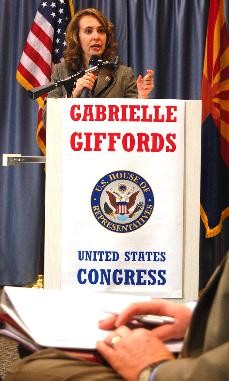District Eight Representative Gabrielle Giffords (D-AZ) held up a map of the United States showing states that are currently in recession or at risk, to kick off a presentation on the federal government’s economic stimulus plan and how it will be infused into the city of Tucson.
In the meeting held yesterday in the Tucson and Catalina rooms of the Student Union Memorial Center, Giffords presented an overview of the aims of the stimulus plan, specifically touching on unemployment, education, science and renewable energy funding.
“”I believe that in order for us to maximize the opportunity that we have, we are going to have to work together; state, city, federal, local, national, all of us coming together regardless of party affiliation,”” Giffords said. “”We have to make sure that we can get our economy back on track.””
According to the American Recovery and Reinvestment Plan that Giffords presented, the January nationwide job losses totaled 598,000, with 3.6 million jobs having been lost since December 2007, marking the largest 13-month job loss in the history of the country.
As a result of the job losses, unemployment has grown to 7.6 percent, the highest since 1983, according to the plan.
On average, 6,600 jobs are lost a month in Arizona, totaling 65,700 jobs lost since the beginning of 2008. During this time Arizona’s unemployment rate has risen 4.2 percent and now sits at 6.1 percent, Giffords said.
Under the $787 billion economic stimulus package, which President Barack Obama is expected to sign Today, Giffords said 70,000 jobs, including 8,100 in district eight, would be saved or created.
Around 2,080,000 workers would receive an $800 tax cut, 75,000 families would be eligible for $2,500 college tax credit, Giffords said. For 204,000 jobless workers, the package would expand unemployment insurance and fund the modernization of 193 Arizona schools.
While explaining the hardships that both the state and country are facing, Giffords spent time discussing what she said is one of the issues she is most passionate about -ð education.
She explained that Arizona students are quickly falling behind in math. Focusing mostly on elementary education, Giffords noted that 30 percent of Arizona fourth graders are considered below the average in math, 6 percent above the national average. In eighth grade, 39 percent of Arizona students are below proficient as compared to 33 percent nationwide.
Giffords broke down the allocation for stimulus funding, specifically in the field of science. Six billion dollars would be given to the Renewable Energy and Electric Power Transmission Loan Guarantee Program. Also, $3.4 billion would be allocated for Carbon Sequestration for research and development. Lastly, $6.5 billion would be filtered into increased borrowing for the Western Power Administration and the Bonneville Power Administration to fund transmission and other renewable energy projects.
After Giffords spoke, Tucson Mayor Bob Walkup explained how Tucson and Southern Arizona have been affected by the economic recession and how the citizens of Tucson will see the incoming money spent.
Walkup explained how the majority of Tucson’s general fund, comes from a 2 percent local sales tax. According to Walkup there is a misconception that property tax contributes largely to the state budget, however it only produces about $5 million.
“”We started out at $502 million, the first look at ’09 got us down to $470 million and we are now looking at the 2010 budget as about $444 million. That is a substantial reduction of the general fund,”” Walkup said. “”The high watermark for employment in the city was 2004 and it was 6,099 in the city. Today we are at 5,600; we are going to end next year, 2010 at 5,300. Our total employment within the city is coming down.””
Walkup continued by explaining how the economic stimulus plan will be immediately infused into the city of Tucson. He said he believes people want to see the money from the plan put to use right away.
“”The region is getting something in the neighborhood of around $48 million. There are 15 projects that are ready to go within the region, they are generally dealing with roads and resurfacing roads and fixing safety issues on our roads,”” Walkup said. “”Roads seem to be something that we can mobilize very quickly. It puts a lot of people to work and affects the suppliers of material. Transportation and roads seem to be a major way that we can get money flowing in this area right away.””
Walkup said once the stimulus bill passes, the public would want equipment on the street the next day.
“”If we are going to do something about faith and confidence in our future, people want to see something happen,”” Walkup said.









